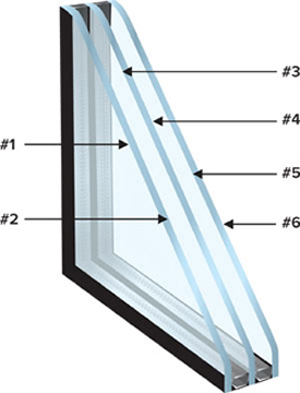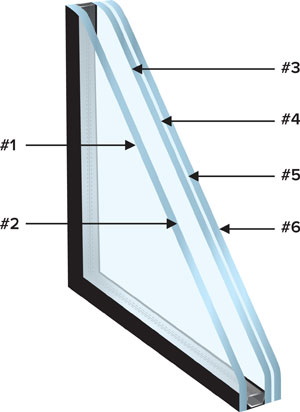A Plant Tour: Single-Source Glass Fabrication
Additional Manufacturing Processes
Beyond heat treatment there are several other common techniques and methods for finishing the primary glass fabrication process, many of which can be handled by a single-source fabricator of insulating glazing units. The main processes of interest to architectural specifiers include:
▶Laminating. An interlayer is sandwiched between two glass lites, and the layers are fused under heat and pressure. The resulting panels will remain in the opening's frame if the glass breaks, so this product qualifies as safety glass. Different interlayers are available, and each offers unique properties and capabilities.
▶ Coating. As noted in ASTM C1376, various methods are used to coat glass to achieve desirable aesthetic and performance properties. To address energy requirements, glass can receive a layer of ultra-thin metallic coating. There are two major categories:
· Sputter coat applied by MSVD allows for multiple, uniform thin coats and is a key process for single-source fabrication of insulating glass units. It also allows for a wide variety of fabrication processes that are desired by architects and end-users to enhance building aesthetics and performance.
· Pyrolytic coating is applied by CVD during the float process, making it a durable product. However, pyrolytic glass is limited by number of thicknesses and color options.
▶ Painting. As opposed to ultra-thin metallic coatings, paint layers on architectural glass are visible to the naked eye. Painting can be rolled on, as with spandrel glass, or applied with silk-screen or digital printing technology for areas of a facade where people will view the glass from both the interior and exterior. The latter two methods can produce bold aesthetics, customized patterns, and artistic results. Spandrel and silk-screen products use ceramic frit and offer limited color choices. Digital printing uses a ceramic ink offering more colors and having a lower viscosity than ceramic frit.
With silk-screen printed imaging, ceramic frit is forced through a mesh screen onto the glass surface and fired into the glass. Digital printing techniques are directly applied onto the glass and allow for multiple colors and more detailed imaging. Screen printing may be useful for replicating standard patterns in a limited color offering, but digital printing can offer more colors and highly customized designs.5
▶ Insulating. Insulating glass units contain two glass components that are separated by a hermetically sealed space may contain air or argon gas for added thermal performance.
▶ Special fabrication. To create glazing products for special applications that require shaped, curved or nonrectilinear edges or special penetrations (or both), a single-source fabricator will have capabilities for precision-cutting of holes, notches, cutouts and specialized edgework.
Manufacturing
There are innumerable configurations of glass units, depending on the desired performance and other project constraints. Savvy architects consider all of the potential variables to optimize their specification for a building project. In this way, it is valuable to break down the various component categories and related processes used in creating IGUs, whether by a multiple-source supply chain or a single-source fabricator.
The key categories to consider in project design include substrates, insulating type, coatings, laminate, and printing technique. (See “Fabricating the IGU” on the next page.)
There are a number of other technologies and materials that are incorporated into an IGU. Sealants are critical, for instance, and IGUs are often constructed with two types in combination. The primary seal is typically polyisobutylene (PIB), used to prevent moisture transmission into the air/gas space. The secondary seal is typically silicone, the adhesive properties of which hold the IGU together. Fabricators may offer sealants in black or grey.
Spacers, typically available in color choice of black or mill finish, can be made from stainless steel, aluminum or composite materials—the choice of which depends on desired performance attributes. The standard spacer fill is air, but argon is also available from most fabricators, for increased thermal performance.
Assembly
IGU assembly is crucial to performance, and for this reason many glass system experts and façade consultants will recommend working with a single-source fabricator to reduce the possibility of error. Perhaps most important is the exterior outboard lite. This lite faces wind, weather, sun, impact and more on its exterior surface, called the #1 surface. The interior surface, #2, most frequently receives the low-E or reflective coating, and is also the preferred surface for applying ceramic frit. The #3 surface can also serve as coated surface, and even #4 may be used when there is a third lite, as in triple-glazed units.


Images © courtesy of Viracon
Left: Different glass lites must be coated and strengthened properly for best IGU performance. This section shows a corner of a triple IGU. Right: This IGU is an insulating laminated unit, and the laminated lite is shown on the inboard side of the unit.
(Note that laminated glass, though it may appear optically to be monolithic, for the purpose of glass surface nomenclature and sequencing is considered to comprise two separate lites. So laminated glass used as an interior lite—called insulating laminated—bears the #3, #4, #5 and #6 surfaces.)









